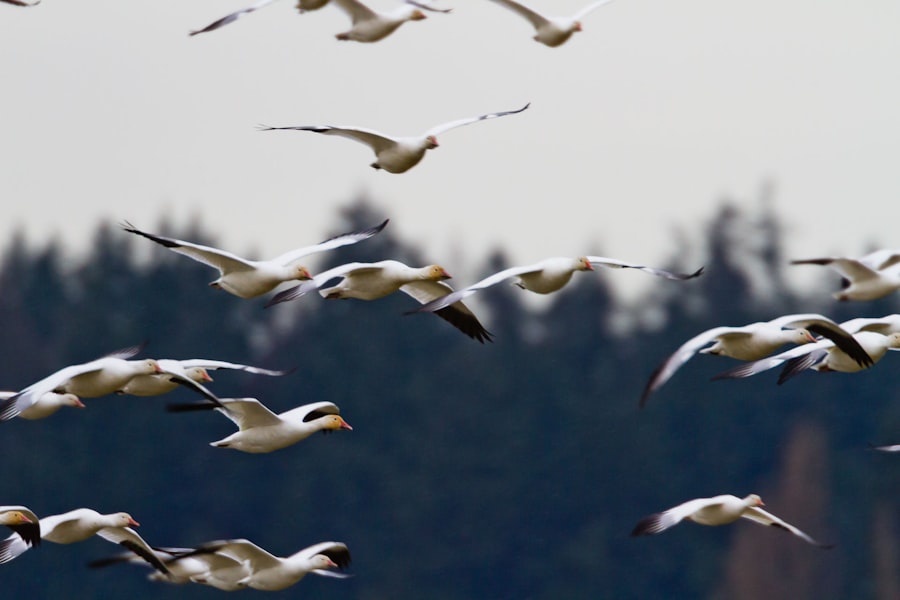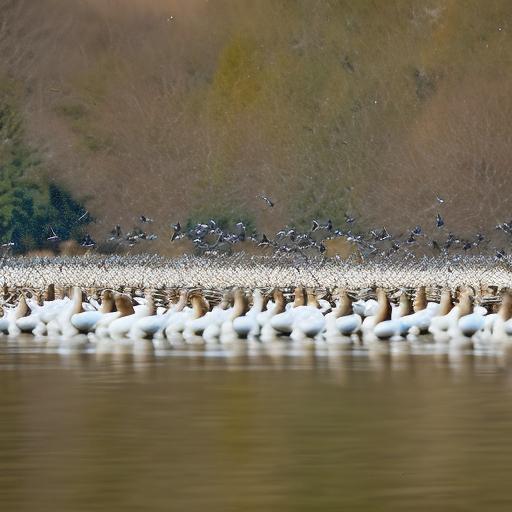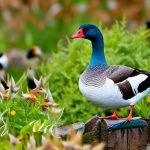Geese herding has a long history that dates back centuries. It was originally practiced as a means of transportation and as a way to protect crops from pests. Today, geese herding plays an important role in agriculture and conservation efforts. Geese are natural grazers and can help control weeds and pests in fields, reducing the need for chemical pesticides. Additionally, geese herding can be a sustainable and eco-friendly alternative to traditional methods of pest control.
If you’re interested in getting started in geese herding, there are a few key steps you’ll need to take. First, you’ll need to acquire the necessary knowledge and skills. This can be done through research, attending workshops or training programs, or working with experienced geese herders. Next, you’ll need to choose the right breed of geese for your operation. Different breeds have different characteristics and temperaments, so it’s important to select a breed that is well-suited to your needs. Finally, you’ll need to invest in the necessary equipment and set up appropriate infrastructure for your geese herding operation.
Key Takeaways
- Geese herding is an important skill for farmers and ranchers to manage their flocks and protect their crops.
- Understanding the behavior of geese is crucial for successful herding, including their social hierarchy and natural instincts.
- Choosing the right breeds for geese herding depends on factors such as temperament, size, and adaptability to different environments.
- Essential equipment for geese herding includes herding sticks, collars, and fencing, and training techniques should focus on positive reinforcement.
- Common challenges in geese herding include aggression, escape attempts, and health issues, but can be overcome with patience and proper management.
Understanding the Behavior of Geese: Key Factors to Consider when Herding
In order to successfully herd geese, it’s important to understand their natural instincts and behaviors. Geese are social animals that live in flocks and have a strong sense of hierarchy. They have a natural instinct to migrate and will often follow a leader. Geese also have a strong instinct to protect their territory and will become aggressive if they feel threatened.
There are several factors that can affect the behavior of geese. These include their age, sex, breeding season, and environment. Younger geese are generally more curious and less cautious than older geese. During breeding season, male geese can become more aggressive and territorial. The environment in which the geese are kept can also have a significant impact on their behavior. For example, if the geese are kept in a small, confined space, they may become stressed and exhibit aggressive behavior.
To work with geese behavior and achieve successful herding, it’s important to establish yourself as the leader of the flock. This can be done through consistent and confident handling, as well as positive reinforcement training techniques. It’s also important to provide a safe and comfortable environment for the geese, with plenty of space to roam and access to fresh water and food.
Choosing the Right Breeds for Geese Herding: Tips and Recommendations
When it comes to choosing the right breed of geese for herding, there are several factors to consider. First and foremost, you’ll want to select a breed that is known for its herding abilities. Some popular breeds for geese herding include Toulouse, Embden, and Chinese geese. These breeds are known for their size, strength, and ability to work well in a herding setting.
In addition to herding abilities, there are other characteristics to look for in a good herding breed. You’ll want to choose a breed that is hardy and adaptable to different climates and environments. It’s also important to consider the temperament of the breed. Some breeds are more docile and easy to handle, while others can be more aggressive or skittish.
When selecting the right breed for your operation, it’s important to consider your specific needs and goals. If you’re primarily interested in using geese for pest control in agricultural fields, you may want to choose a breed that is known for its grazing abilities. On the other hand, if you’re interested in using geese for recreational purposes or as a sport, you may want to choose a breed that is known for its agility and speed.
Essential Equipment for Geese Herding: What You Need and How to Use It
In order to effectively herd geese, you’ll need to invest in some basic equipment. The most essential piece of equipment is a herding stick or crook. This tool is used to guide and direct the geese, and can also be used to gently nudge them in the right direction. It’s important to use the herding stick in a gentle and non-threatening manner, as geese can become aggressive if they feel threatened.
Another important piece of equipment is a herding dog. Border Collies are commonly used for geese herding, as they are highly intelligent and have a natural instinct to herd. A well-trained herding dog can help you control the movement of the geese and keep them in line.
Other equipment that may be useful for geese herding includes fencing or netting to create boundaries, feeding troughs or buckets for food and water, and a shelter or coop for the geese to rest and roost. It’s important to set up appropriate infrastructure for your geese herding operation to ensure the safety and well-being of the geese.
When using equipment for geese herding, it’s important to use each piece effectively and safely. Take the time to familiarize yourself with each piece of equipment and learn how to use it properly. This may involve reading instruction manuals, watching instructional videos, or working with experienced geese herders. It’s also important to regularly inspect and maintain your equipment to ensure that it remains in good working condition.
Training Techniques for Geese Herding: Positive Reinforcement and Other Methods
Training is an essential part of geese herding, as it helps establish a bond between the handler and the geese and teaches the geese how to respond to commands. There are several different training techniques that can be used for geese herding, but one of the most effective methods is positive reinforcement.
Positive reinforcement training involves rewarding the geese for desired behaviors. This can be done through the use of treats, praise, or other rewards. For example, if a goose successfully follows a command or moves in the desired direction, it can be rewarded with a treat or praise. Over time, the geese will learn to associate the desired behavior with the reward and will be more likely to repeat it.
In addition to positive reinforcement training, there are other methods that can be used for geese herding. These include using vocal commands, body language, and physical cues to communicate with the geese. It’s important to be consistent and clear in your commands and cues, as geese are highly observant and can pick up on subtle changes in behavior.
When training geese, it’s important to be patient and persistent. Geese are intelligent animals, but they can also be stubborn and independent. It may take time for them to learn and understand the commands and cues you are using. It’s also important to keep training sessions short and frequent, as geese have short attention spans and can become bored or distracted easily.
Common Challenges in Geese Herding and How to Overcome Them

Like any agricultural endeavor, geese herding comes with its fair share of challenges. One common challenge faced by geese herders is managing the behavior of the geese. Geese can be stubborn and independent animals, and it can be difficult to get them to follow commands or move in the desired direction. To overcome this challenge, it’s important to establish yourself as the leader of the flock and use consistent and confident handling techniques.
Another common challenge is dealing with aggressive or territorial behavior from the geese. Geese have a natural instinct to protect their territory and can become aggressive if they feel threatened. To prevent aggression, it’s important to create a safe and comfortable environment for the geese and to handle them in a calm and non-threatening manner. It’s also important to be aware of the signs of aggression and to take appropriate action if necessary.
One of the biggest challenges in geese herding is preventing escapes. Geese are strong and agile animals, and they can easily fly or swim away if given the opportunity. To prevent escapes, it’s important to ensure that your fencing or netting is secure and that there are no gaps or openings that the geese can squeeze through. It’s also important to regularly inspect your fencing or netting for any signs of wear or damage, and to repair or replace it as needed.
Health and Safety Concerns for Geese Herding: Preventing Injuries and Illnesses
When it comes to geese herding, there are several health and safety concerns that need to be addressed. One of the biggest concerns is preventing injuries to both the geese and the handlers. Geese can be strong and aggressive animals, and they can cause serious injuries if they bite or attack. To prevent injuries, it’s important to handle the geese in a calm and non-threatening manner, and to use appropriate safety equipment such as gloves or protective clothing.
Another health concern is preventing the spread of diseases among the geese. Geese are susceptible to a variety of diseases, including avian influenza, botulism, and parasites. To prevent the spread of diseases, it’s important to practice good biosecurity measures, such as regularly cleaning and disinfecting equipment and facilities, quarantining new birds before introducing them to the flock, and monitoring the health of the geese on a regular basis.
In addition to injuries and illnesses, there are also safety concerns when it comes to working with geese. Geese can be unpredictable animals, and they can become aggressive or panicked in certain situations. It’s important to be aware of your surroundings and to take appropriate safety precautions when working with geese. This may include wearing protective clothing, using safety equipment such as gloves or goggles, and having a plan in place for responding to emergencies.
Best Practices for Managing a Geese Herding Operation: Tips from Experienced Handlers
Managing a successful geese herding operation requires careful planning and organization. One of the most important tips for managing a geese herding operation is to build a strong team. This includes hiring or training experienced handlers, as well as working with other professionals such as veterinarians or animal behaviorists. It’s also important to establish clear roles and responsibilities for each member of the team, and to communicate effectively to ensure that everyone is on the same page.
Another tip for managing a geese herding operation is to have a clear plan and set goals. This includes setting realistic expectations for your operation, as well as developing a timeline and budget. It’s also important to regularly evaluate your progress and make adjustments as needed. This may involve monitoring the health and behavior of the geese, assessing the effectiveness of your training techniques, or making changes to your infrastructure or equipment.
Finally, it’s important to have a strategy for growth and expansion. This may involve increasing the size of your flock, diversifying your services or products, or expanding into new markets. It’s important to carefully consider the potential risks and rewards of growth, and to develop a plan that aligns with your long-term goals and objectives.
Geese Herding for Recreation and Sport: Opportunities and Benefits
While geese herding is primarily practiced for agricultural purposes, there are also opportunities for recreational geese herding. Many people find joy and fulfillment in working with geese and enjoy the challenge of training them to follow commands and move in a desired direction. Geese herding can also be a great way to stay active and spend time outdoors.
Participating in geese herding as a sport can also have several benefits. It can help improve physical fitness, as it requires strength, agility, and endurance. It can also help improve mental focus and concentration, as it requires quick thinking and problem-solving skills. Additionally, participating in geese herding as a sport can provide a sense of accomplishment and satisfaction, as you work towards achieving goals and overcoming challenges.
If you’re interested in getting involved in the geese herding community, there are several ways to do so. You can join local geese herding clubs or organizations, attend workshops or training programs, or participate in geese herding competitions or events. These opportunities can provide a chance to learn from experienced handlers, network with others who share your passion for geese herding, and showcase your skills and abilities.
The Rewards of Geese Herding and How to Get Involved in the Community
In conclusion, geese herding is an important practice that plays a role in agriculture and conservation efforts. It requires knowledge, skills, and dedication, but the rewards can be great. Geese herding can help control pests and weeds in agricultural fields, reduce the need for chemical pesticides, and provide a sustainable and eco-friendly alternative to traditional methods of pest control.
If you’re interested in getting started in geese herding, there are several steps you’ll need to take. You’ll need to acquire the necessary knowledge and skills, choose the right breed of geese for your operation, invest in the necessary equipment, and set up appropriate infrastructure. You’ll also need to develop effective training techniques, overcome common challenges, address health and safety concerns, and manage your operation effectively.
Getting involved in the geese herding community can provide additional opportunities for learning and growth. Whether you’re interested in participating in geese herding as a sport or simply want to connect with others who share your passion, there are several ways to get involved. By joining local clubs or organizations, attending workshops or training programs, and participating in competitions or events, you can learn from experienced handlers, network with others, and showcase your skills and abilities.
In the end, geese herding can be a rewarding and fulfilling endeavor. It allows you to work closely with animals, contribute to agricultural and conservation efforts, and enjoy the benefits of being outdoors and active. Whether you’re interested in geese herding for agricultural purposes or as a recreational activity, there are opportunities for learning, growth, and connection within the geese herding community.
If you’re interested in keeping geese herding, you might also want to check out this informative article on turning a shed into a chicken coop. It provides valuable insights and practical tips on how to transform a shed into a comfortable and functional space for your feathered friends. Whether you’re a beginner or an experienced poultry keeper, this article from Poultry Wizard is a must-read. Read more
FAQs
What is geese herding?
Geese herding is the practice of keeping and managing a flock of geese for various purposes, such as egg and meat production, pest control, or as pets.
What are the benefits of keeping geese?
Keeping geese can provide a source of food, such as eggs and meat, as well as natural pest control for gardens and farms. They can also make good pets and provide entertainment.
What are some common breeds of geese?
Common breeds of geese include Toulouse, Embden, Chinese, African, and Canadian.
What do geese eat?
Geese are herbivores and primarily eat grass, weeds, and other vegetation. They may also eat grains and other supplemental feed.
How do you herd geese?
Geese can be herded by using trained dogs, fencing, or by simply guiding them with a stick or other object. It is important to establish a routine and consistent feeding schedule to keep geese in a specific area.
What are some common health issues for geese?
Common health issues for geese include respiratory infections, parasites, and injuries from predators or other animals. It is important to provide proper nutrition and housing to prevent these issues.
What should be considered when building a goose coop?
When building a goose coop, it is important to consider the size and number of geese, ventilation, and protection from predators. The coop should also be easy to clean and provide adequate nesting areas.
Meet Walter, the feathered-friend fanatic of Florida! Nestled in the sunshine state, Walter struts through life with his feathered companions, clucking his way to happiness. With a coop that’s fancier than a five-star hotel, he’s the Don Juan of the chicken world. When he’s not teaching his hens to do the cha-cha, you’ll find him in a heated debate with his prized rooster, Sir Clucks-a-Lot. Walter’s poultry passion is no yolk; he’s the sunny-side-up guy you never knew you needed in your flock of friends!







